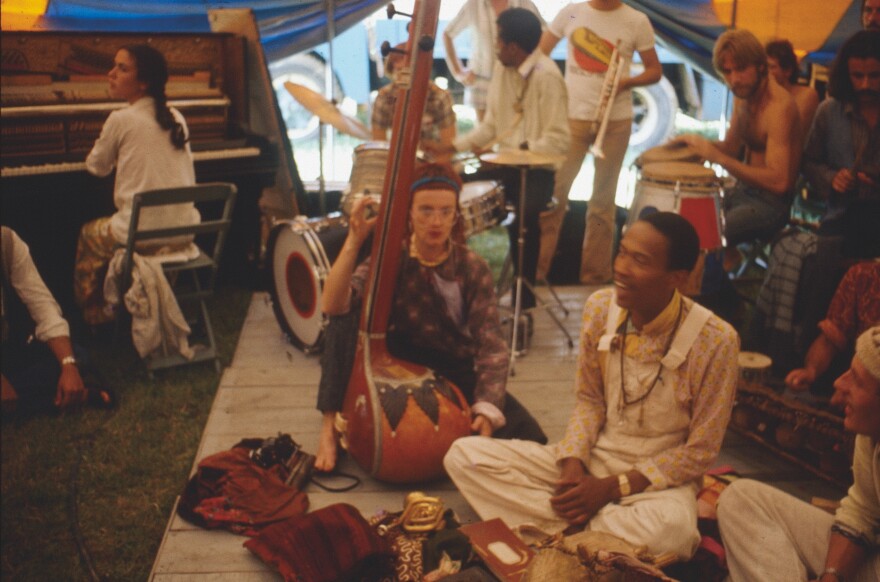During their lives, the trumpeter Don Cherry (1936-1995) and his wife, visual artist and designer Moki Cherry (1943-2009), were best known to music fans for their collaborations. By the mid-1960s, Don Cherry was a constant sideman for many of that moment's most important musicians: Ornette Coleman, John Coltrane, Sonny Rollins, Steve Lacy, Archie Shepp and Albert Ayler. Moki Cherry created the tapestries and paintings that served as album covers and set designs for her husband.
Over the summer, their work together and individually will be reevaluated through several avenues. Brooklyn's Blank Forms is presenting an exhibit, Organic Music Societies: Don and Moki Cherry, which runs through July 16. In addition, the non-profit organization recently published a 496-page book by the same name that features photographs of Moki Cherry's visual work as well as scholarly essays of their music. Out today, the gallery just released two archival recordings: The Summer House Sessions and Organic Music Theatre: Festival de jazz de Chateauvallon 1972. Then in Chicago, the Corbett Vs. Dempsey Gallery will present Moki Cherry, Communicate, How?: Tapestries and Paintings, 1967-1980, which opens Sept. 3 and runs until Oct. 9. The organizers of the Chicago show also plan to release music by Don Cherry from that era.
"Don Cherry rewrote the book," trumpeter Steven Bernstein tells NPR. "Both in sound and importantly in structure, it was music that was off the grid." Cherry's sound was lean, introspective and tart, an ideal foil to the often burly, flamboyant tones of the saxophonists with whom he played. And although his style was often characterized as avant-garde, Cherry was also comfortable in more straight-ahead settings as illustrated by the recently released Cherry Jam.

Moki (born Monika Marianne Karlsson) met Don Cherry when he was touring Stockholm with Sonny Rollins in the early '60s. The relationship developed in Sweden and New York where she worked both in the art and fashion worlds. She created the covers for many Cherry recordings — Mu, Organic Music Society, Eternal Now and Brown Rice among them — and together they began to envision spaces for creativity that could exist outside of the toxic pressures of commercialized culture. The couple eventually took residence in a schoolhouse in Tågarp, a village near the southern tip of Sweden. There, a whole new approach began, as education, music, performance and visual arts became one entity. Moki Cherry's motto served them for a creative decade: "the stage is home, and home is a stage."
Cherry had begun this international approach on his three records for Blue Note in the '60s — Complete Communion, Symphony for Improvisers and Where is Brooklyn? — but in Sweden, he went further, obliterating the borders of genre and enthusiastically mixing musical traditions from Asia, Africa and Latin America. The two Blank Forms recordings nearly trace the evolution of Cherry's style: The Summer House Sessions extend his work on Blue Note, while Organic Music Theatre provides a template for Codona, the cooperative group between Cherry, Brazilian percussionist Naná Vasconcelos and sitarist Collin Walcott that recorded three stellar albums for ECM Records in the late '70s and early '80s.
Vibraphonist, pianist and composer Karl Berger says that working with Cherry in these settings was "a mind-opening experience that changed almost everything for me."
Although Moki Cherry played music, her virtuosity was in other disciplines and her impact, until now, has gone less appreciated. John Corbett first took an interest in Moki Cherry's work from the album covers she created for her husband, but as he learned more about their lives, he and his Corbett vs. Dempsey Gallery partner Jim Dempsey dove deeper, eventually travelling to Sweden to meet with Neneh Cherry (a recording artist and Moki's daughter from a prior relationship) and her daughter Naima Karlsson who were instrumental in both exhibits. They became eager to show Moki's work and "how it functioned both as an autonomous artistic production and as an integral part of the fabric of the performances in which it was sometimes deployed. We wanted to explore Moki's work better, her own individual artistic gravitas, which was enormous, and its relationship to Don Cherry's groundbreaking multicultural conceptions."
Corbett cited rectification as a key motive in the upcoming exhibit: "We hope to deepen the understanding of Moki's own artistic achievement, not only in tandem with Don, but on her own terms, as a participant in and architect of an important and undersung counter-cultural artistic initiative. Many of Moki's contributions were absorbed into an overall communal atmosphere that was at the heart of what they were doing. But her work is brilliant, and she deserves to be appreciated both independently and interdependently as a visionary artist."
Several decades later, Don and Moki Cherry's collective and individual work carries greater weight as conventional structures — across art, education, music — have shifted. Moki's visual sensibility — elemental and abstract — and Don's globalist attitudes toward music resonate more deeply in a world where many people are currently reconsidering or actually rebuilding their lives from scratch. Frustrated by the ways things were, they dreamed what could be.
Copyright 2021 NPR. To see more, visit https://www.npr.org. 9(MDA2MzgyMjYzMDEyODg5MDE4NjU4NTRjOA004))



